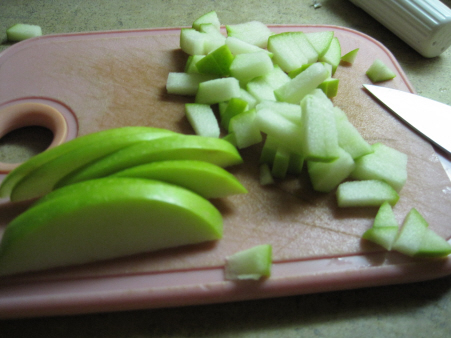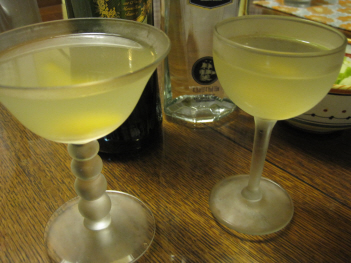I love the Appletini.
Mind you, I’ve never actually had one — not a “real” one, anyway, assuming you can call a drink that’s become an icon of all that’s saccharine and false about cocktails “real.” Even when I was younger and (more) stupid, when I was less picky about what went into my glass, a drink that both looked and tasted like Jolly Ranchers just seemed to be wrong, not only a fraudulent fake of a proper cocktail, but yet one more molestation of a natural flavor.
But as someone who makes his living writing about drinks, the Appletini has been a godsend, a useful tool for mocking all that’s wrong with bars, and an instrument of warning to those who are tempted to take the quick, easy way out. Plus, with the drink’s pioneering appropriation of the ‘tini suffix, the Appletini became a punchline in itself, a gaudy green scapegoat in a cocktail glass for craptinis everywhere. Long may it wave.
There’s a problem here, though. Y’see, for all its faults, an Appletini has one thing going for it: it tastes decent to a lot of people (so I assume — again, I’ve never had one, but it’s easy to come to that conclusion) — and why not? It tastes like apples (kinda, or at least what apples taste like as interpreted by food scientists), and apples are awesome. Even spirits actually made from apples don’t really, truly taste like apples (except on a certain ethereal, completely engaging level), thanks mostly to the effects of barrel aging — not that I’m complaining, of course. But, apples — why not? If you can take a drink that’s emblematic of all that’s fake in mixology, and render it in a natural way, isn’t that a worthwhile cause (or at least a potentially interesting way of spending a Monday evening)?
Fortunately, today is Mixology Monday, and as this month’s host Jacob Grier chose to frame it, this month’s event is themed “Retro Redemption.” Jacob’s challenge is to take a misbegotten concoction, preferably from recent decades, and tweak it into something appealing to the growing craft-cocktail crowd. And if ever a drink needed tweaking, it’s the Appletini.
So, here’s how I’m going to proceed: I’m going to take the Appletini at its most literal, and break it down by the constituent parts of its name — first, it has to have an apple influence; and second, it has to earn that ‘tini suffix.
My starting ground rule is that the drink’s base elements must be gin (vodka? really? are you in the right place?) and dry vermouth; bonus points if the orange bitters stay in the equation. And for the apple? It must be a natural component, something from an actual apple, not a mock-up of apple flavor or a processed apple product. Simply adding an ounce of apple juice or the like to the drink would be cheating on a certain level — my self-imposed rule stipulates that the drink must still be identifiable as a martini — but what if I process the drink through an apple?
We know from experience that apples and dry vermouth work fantastic together, as demonstrated in Audrey Saunders’ Eve — a simple five-day infusion of Macintosh apples in vermouth. Had I given this project much thought prior to the last couple of days, I might’ve smacked a bottle together, but by the time I started thinking about the apple + martini project earlier today, the infusion ship had sailed.
 Or had it? No, I didn’t have five days for an infusion, but I had a few minutes — not to mention a couple of Granny Smith apples and an iSi cream whipper, which, by following the nitrogen infusion process first explored by Dave Arnold, was all I needed to do a flash-infusion of apples into my drink, and which hopefully would only bring the delicate, fruity notes of the fruit, without the darker, bitter flavors that come from oxidizing apples.
Or had it? No, I didn’t have five days for an infusion, but I had a few minutes — not to mention a couple of Granny Smith apples and an iSi cream whipper, which, by following the nitrogen infusion process first explored by Dave Arnold, was all I needed to do a flash-infusion of apples into my drink, and which hopefully would only bring the delicate, fruity notes of the fruit, without the darker, bitter flavors that come from oxidizing apples.
Okay, this post is way too chatty by this point — let’s get down to the recipe:
The Appletini is Dead! Long live the Appletini!
makes 3 drinks
- 6 ounces gin (I used Plymouth)
- 3 ounces dry vermouth (I used Noilly Prat)
- 1 large (or 1 1/2 small) Granny Smith apple
- 1 dash orange bitters
- lemon zest, for garnish
- Core the apple and chop it, peel and all, into small chunks. Place the apple chunks in the canister of an iSi cream whipper, and add the gin and vermouth.
- Seal the whipper, and get your stopwatch ready. Use a N2O charger to pressurize the whipper, and swirl the contents around for 30 seconds; at the end of 30 seconds, place the whipper on the counter and let it rest an additional 30 seconds.
- Rapidly depressurize the whipper by placing a plastic container over the spout (to catch the spraying liquid) and squeeze the lever. Once the whipper is completely depressurized, strain the liquid into a large glass. Let it rest a few minutes before using — the flavor develops better with a little time.
- Proceed as with a standard cocktail: place three ounces of liquid in a mixing glass, add a dash of bitters along with a bunch of ice, and stir until chilled. Strain into chilled cocktail glass; hit it with the lemon zest.
 This worked out better than expected. The liquid went into the canister a light straw color (from the vermouth), and came out a delicate, chlorophyll green. At first sip, the apple was barely noticable — it was all martini, with a softer, rounder edge.
This worked out better than expected. The liquid went into the canister a light straw color (from the vermouth), and came out a delicate, chlorophyll green. At first sip, the apple was barely noticable — it was all martini, with a softer, rounder edge.
But after the liquid rested a bit more, the apple flavor developed; the drink was still no fucking doubt a martini, but it had a lightly floral aroma, and a lingering finish that was had the bright, acidic crispness and the very gentle sweetness of a fresh Granny Smith apple. You wouldn’t sip this drink and have “apple” immediately leap to mind, but the fruit gradually manifested itself as a welcome addition to the martini’s familiar flavor — as though the bright freshness of the fruit was one of the botanicals in the gin or the vermouth, pronounced enough to be identifiable as a flavor, and definitely lending a soft, fruity caress to the drink, but not attempting to seize control of the drink’s character from its spirituous base elements.
Does it taste like a “real” Appletini? Hell, no. That’s why I’m still drinking it…
Anyway, that’s my MxMo contribution for this month. Head over to Jacob’s place and see what others have got up to for this round.

Hm.. why not use Williams Gin which uses distilled apple cider as a base, and then use applejack, calvados or some other apple eau de vie as a modifier (similar to the vodka in the Vesper), then the vermouth, and *then* infuse? Three layers of apple flavor.
..we all consider the Vesper a martini variant, right? ._.
This looks very tempting.
I tried this before – though a bit different. I took my time and rested the apples in the liquid for a couple of weeks.
The result was quite good – though nothing, what you really could call an Apple’tini. It tasted like a martini – with a softer edge with some brightness… exactly what you described.
I rather like to take the Apple’tini completely out of the Neo’tini corner – Gin [you could even use infused vodka], fresh green apple juice and a sour syrup [my “new” secret weapon – which is rich syrup with added citric acid] shaken and served preferred in a whiskey tumbler on the rocks [or if it really needs to be in a cocktail glass] – is a bright example of an apple cocktail, which though sports the quality of modern mixology but also keeps the essence of the “original” apple’tini…
Great post. Definitely going to give this one a try. Tried making something similar a few months back with muddled apple that did not turn out well so had given up on the idea.
I like your take on the appletini! We’ve tried a few different variations trying to make the appletini palatable and respectable but I’ve never busted out the N20 before!
The sad thing is that most people will not appreciate the hard work that goes into this kink of concoction-tini, nor would they even realize the subtilties. sad, sad, sad